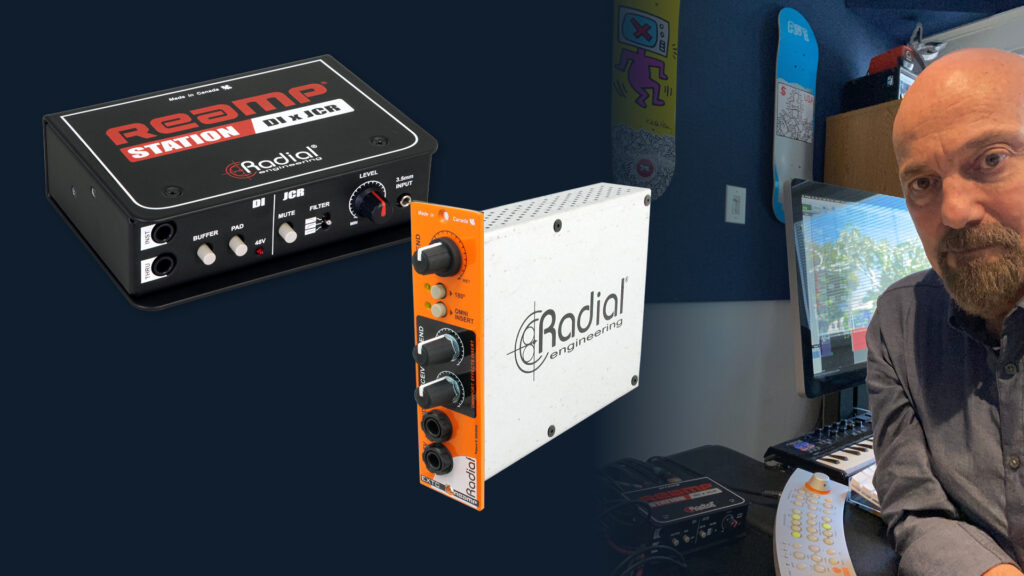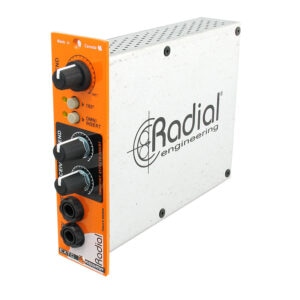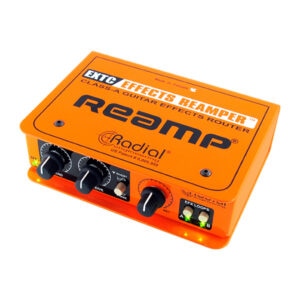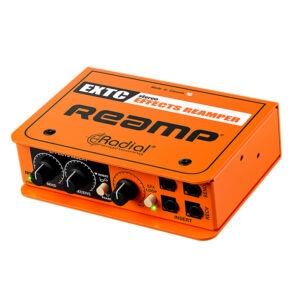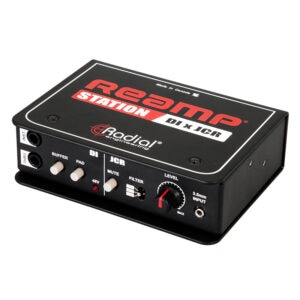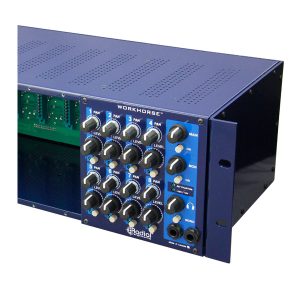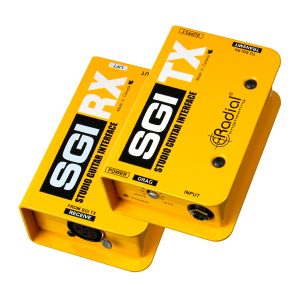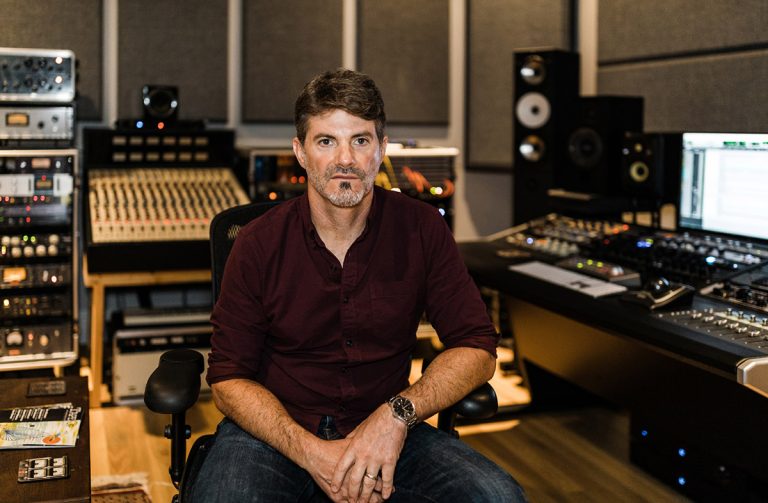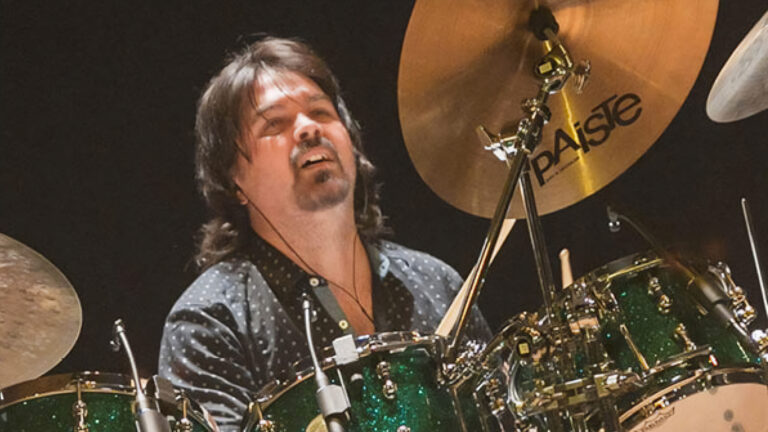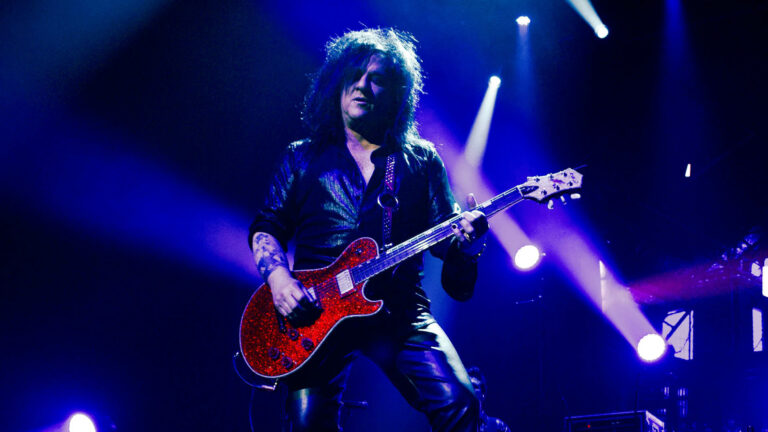In this series, we talk to some top names in the world of production, to learn about some of the different ways they use Reamping as part of their everyday process in the studio. Our interviewees share their insights into some of the original and creative ways they Reamp® that may not have occurred to you before…
In this interview we chat with renowned record producer, mixer and engineer Joe Chiccarelli.
Radial: Joe, you’ve been reamping for a long time, even before you started using Radial Reamp® boxes. Talk about what it was like before Radial came out with its first reamp box.
Joe: Before Radial, reamping was something that I always did with a bunch of makeshift connections — just stringing things together, whether it was an XLR out to a quarter inch and into a guitar amp or an RCA into an old spring reverb. It was something that we always did back in the day, but never did properly. And as a result, we always battled the hum and the too much gain issues, et cetera, et cetera. But there was nothing else at the time, so you kind of just made stuff work.
Radial: You’ve traditionally used a lot of effects boxes in your reamping setup, correct?
Joe: Yes, I like using effects boxes and guitar stomp boxes, they’ve been part of my workflow for a long, long time. I find that, in general, the cheaper the device or box, the more personality it has.
Radial: What type of boxes do you like to use?
Joe: I’m never afraid of using lo-fi devices or guitar boxes. Back in the ’80s, those multi-effects pedals that were made for guitars and keyboards were always great. Things like the old Zoom and Yamaha boxes and the Tom Scholz Rockman, things like that.
Radial: What’s the appeal of these types of boxes?
Joe: I mean, all that older stuff just has so much character. Especially doing rock music or alternative rock music, you want stuff that has as much personality as possible. So using those older boxes has always been a part of my workflow.
Radial: What was interconnecting the technology like back in those days, especially in a Reamp® setup?
Joe: (laughing) No one ever really did the interconnections right. You were always gluing something together! Like if something had an eighth inch plug and you were connecting it together with alligator clips or all that silly shit! You’d find a way to make it work!
Radial: You started out reamping using one of John Cuniberti’s first Reamp® boxes back in the day, right?
Joe: Yes I forget the year, but it was great when John came out with his Reamp® box because it just made so much sense to properly transform or isolate the signal and match the impedance. It really simplified the process and made it much more reliable and relevant.
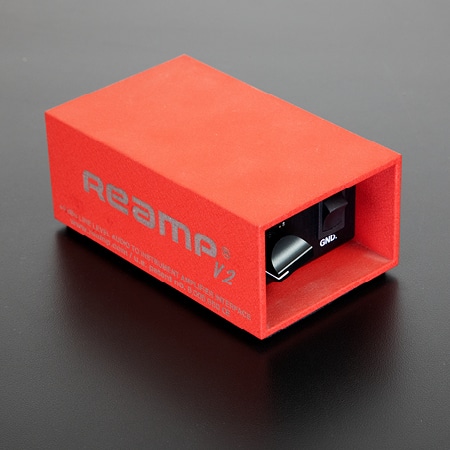
Click here to read an interview with John.
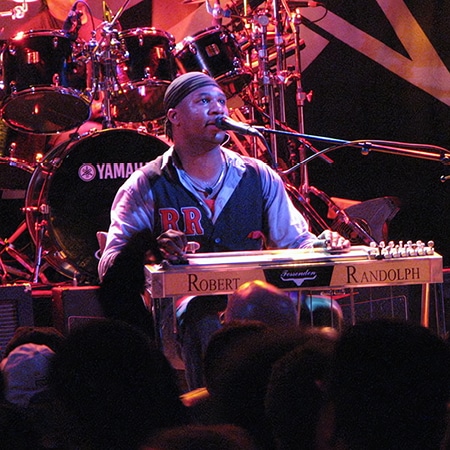
Radial: Let’s talk a little bit about recent projects where you’ve used Radial Reamp® boxes.
Joe: Well, reamping is something that is more than likely part of most projects I do. That said, I’ve been working recently with Robert Randolph, an amazing blues and pedal steel style player. He’s an amazing, incredible musician, a really wonderful artist. And we’re constantly sending stuff back into his pedal board or pedals that are at the studio. We’re working on a new album right at the moment and definitely a number of the steel tracks have gone through a full tone delay and a bunch of guitar stomp boxes.
Radial: Can you give an example?
Joe: One thing we do a lot of is feed the steel back into either a Roland Space Echo or a full tone tape delay and then print that back. That’s been really cool to do. At my personal studio here, I have two Radial EXTC boxes and very, very often they are connected to the Space Echo because that box has such a personality, especially on vocals. There’s a certain character in the way the Reamp® on the Roland Space Echo distorts that I love adding it into vocal tracks. It really gives the vocals a little bit more bite and presence. So I’m very, very often taking a vocal track from Pro Tools, feeding it via the EXTC into the Space Echo, using a little bit of delay and using the overload from the Space Echo to be a part of my vocal sound. Reamping makes this type of approach possible.

Radial: Cool, what about other recent projects?
Joe: I recently did another Morrissey album. I’ve done five albums with Morrissey. Even in the tracking sessions, we were constantly feeding guitars to a second guitar amp because in some cases we wanted a cleaner or dirtier tone that we didn’t quite get on the tracking dates. In fact, that’s maybe one of the first times I think I really saw the benefit of reamping was when using multiple guitar amps for a player. In fact, some years ago I did an album with a British artist named Keaton Henson who was this very moody, atmospheric, almost like bedroom pop, And it’s storytelling, very moody, very intimate. It’s really one guitar, one sort of droney rhythm guitar with a lot, a lot of effects on it.
Radial: Describe what you did during those sessions.
Joe: Often in tracking I would take his DI because the DI was really perfect to feed to effects, but I would also print that DI and then later I’d go back and feed it through a different guitar amp. And maybe that guitar amp would have some tremolo or a spring reverb on it, and it would be a different tone than the original guitar amp and I could pan them left and right and get a much wider image there.
Radial: Was this a new approach for you, or something you’ve done before?
Joe: For years I’ve been doing that to kind of get fake stereo guitar sounds, especially for artists like that where you don’t want a lot of overdubs on the album. You want it to be pretty true to what they do, but you definitely want a bigger picture and more layers to the production without adding unnecessary instruments or parts. So it’s a great way to fill out the sound but kind of keep it honest.
Radial: So do you pretty much, as a standard, particularly when you’re recording guitar, go ahead and set up a DI so you just have it?
Joe: Not always. I’ve never been the one to just print a DI from the guitar. A lot of people do that, but I almost find that there’s too many possibilities there. I’ll do it when I know that I’m going to specifically do some experimenting with guitar tones after the fact, but I try to really commit to my sounds when I’m tracking if that’s what the project calls for.
Radial: So reamping is a tool that you use regularly, but not all the time, just depending on the project.
Joe: Yes. So even though I do Reamp® things from time to time, I’m also regularly printing sounds as I go, trying to capture them in the moment. Reamping comes when you’re sitting back and starting to overdub the album and you start to hear it and go, “Boy, I wish I had a cleaner guitar sound to go along with that or a dirtier or a more fuzzed up guitar sound to go with that.” Or sometimes it’s very often that you try and overdub something on a section of a tune and it becomes too much to add another part. Like I was saying earlier, it sounds overproduced.
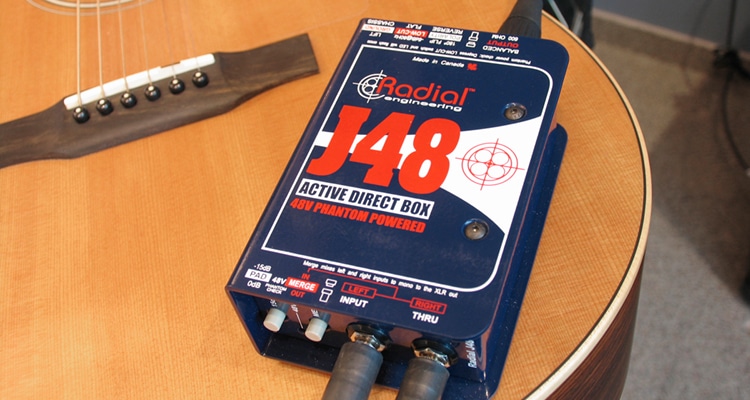
Radial: What’s your approach in that type of situation?
Joe: In essence, all you really have to do is distort the guitar more for that section. Or what sometimes really comes in handy is taking an acoustic guitar and sending an acoustic guitar out to some pedals or to a guitar amp and just kind of electrifying that acoustic. It really works great with a lot of intimate singer songwriters when you need a little bit more power to electrify the acoustic guitar and you just end up blending it in a little bit behind the original and it just gives the acoustic some more life and juice. And it doesn’t really necessarily sound like an electric guitar or an overly distorted acoustic, but it just kind of has a little bit more power.
Radial: I’m glad you mentioned using the Reamp® on an acoustic guitar, not just the electric guitar. Do you also use reamping on other instruments?
Joe: Absolutely. A lot of times I’ll put drums through guitar pedals using a Reamp® setup, whether it’s a Rat distortion pedal or the old Tech 21 Comp Tortion pedal. My studio is at Sunset Sound here in Hollywood, and there’s a kind of counter in the back of Studio One, and it’s very, very common for us to set up a bunch of pedals back there and have it on a send so we can easily send to those pedals and see if you get some kind of interesting sound and then you print it back.
Radial: Is there one special trick that you do with reamping that you can share?
Joe: Sure, one thing that I do often that’s an interesting little trick is to feed the instrument, whether it’s a guitar, drums, or even a synthesizer, back out to a guitar amp or speaker out in the room and not necessarily mic the speaker, but just mic the room.
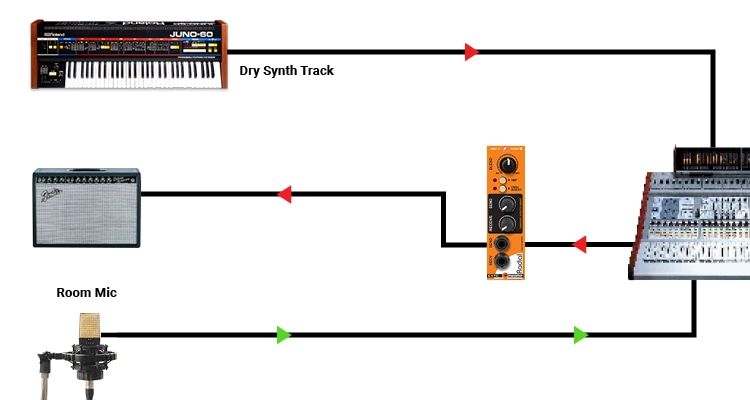
Radial: What effect does this produce?
Joe: It just gets a little bit more 3D image of the sound. Synthesizers can be very kind of one dimensional and it’s always really tricky to get them to blend in with acoustic or electric guitars. So getting them to have some more kind of organic personality is sometimes tricky, and sometimes that’s just in the way that you EQ or compress them, but other times it’s really putting them in an environment like a room, and putting some dimensionality around them. So I’ll often just feed them back out into the room, mic the room and print that ambience.
Radial: Is this often a preferable way to add dimension to a sound rather than to use a reverb or plug-in effect?
Joe: Yes, exactly. When it comes to the three-dimensional elements like reverb or room ambience, plugins just aren’t the same as taking advantage of an actual acoustic space. So that’s one place where reamping really, really comes in handy by adding dimension to a track. So if I feed the sound back out into a guitar amp, I won’t necessarily overdrive the guitar amp. I might keep it pretty clean. And what I’m really interested in is capturing the space between the loudspeaker and the microphone.
Radial: And in those cases, will you do multiple mics or just a mic right on the amp, or do you mic in the room?
Joe: I’d have a pair of mics in the room or a stereo mic or something like that. At that point, it’s really about the ambience.
Radial: You’ve been reamping a long time, and have one of the original John Cuniberti Reamp® boxes, before Radial acquired the design from John. Is there anything in terms of the way that you’ve approached the process of reamping in terms of micing, or cabinets, or has it pretty much stayed the same as when you started?
Joe: I would say it’s stayed the same. If anything, I probably do more where I am using the ambience as opposed to the direct signal then when I started reamping. Back then, it was more about effects devices, stomp boxes, guitar pedals, that kind of thing. So now I use it to get more from the actual room ambience than I do from the pedals when I Reamp®. But like I said earlier, I’m always feeding the signal to my Space Echo or older stomp boxes because they really have a great sound.
Radial: And how does this process of capturing ambiance differ from using a plugin?
Joe: Well, plugin’s can be great. For instance, the UA Space Echo plugins are fantastic, but the one thing that I don’t get is the ability to drive the input and distort the input in the way that I can with the actual hardware device. So when I’m looking for that kind of character to add to a vocal, I’ll actually use the hardware, but when I need just the sort of repeat delay from the Echo device, then I might use a plugin.
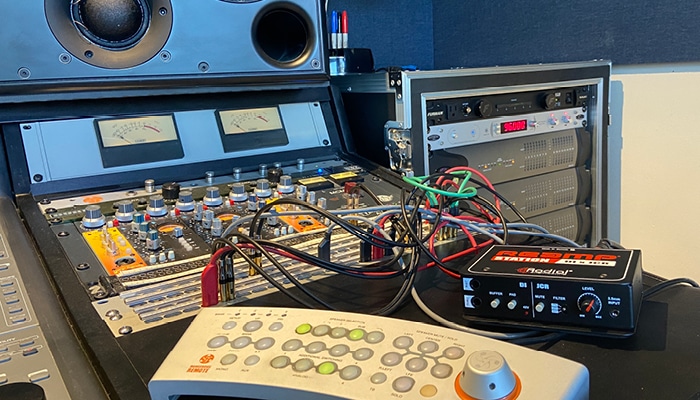
Radial: How does the process of reamping fit into the production decision making down the road, once you’re starting to pull the tracks together?
Joe: When I’m working, I really like to make all my decisions right there off the floor and not leave a whole lot to mystery or to second guessing. So with reamping, it’s more about if I actually get into the process and find that I’m missing something, I would try something different using reamping.
Radial: And is that generally a decision that’s made along with the artist or is that something that you experiment with and then the artist comes back in later and you say, “Hey, check this out?” How does that collaboration process work?
Joe: Usually it’s me just experimenting with things. I’ll say, “Hey, I wasn’t a hundred percent sold on this sound,” or “I wondered if we could have a change-up in sound for this section of the tune. So I took the guitar and I fed it through the bass amp and I over drove the bass amp and I’m thinking maybe just in the bridge of the song we have this more blown up bass texture.” So it’s usually that kind of thing.
Radial: And, in your experience, is the artist generally pretty okay with that process?
Joe: I would say it works out well more often than not. I mean, I think reamping is a pretty common thing. The nice thing is that now everybody knows about the studio and the tricks and all. People know the terminology. So I think for most artists they kind of understand the reamping process. So it’s not uncommon for somebody to come in and say, “Hey, I like the guitar tone we got, but I’m wondering if it could be a little more? Should we have distorted it more or should it have been chorused or whatever?” And you’ll go, “Oh yeah, well, we could feed it out to a clean amp with some chorus effects and see what that does.” It can be something that’s brought to my attention by the artist, but usually it’s me, as I build the record and get close to mixing, that I start to feel this may be lacking a little something here.
The Full EXTC Range:
Radial: Before we wrap up, talk a little bit about the Radial gear you use most often.
Joe: Well, I definitely use the Radial EXTC. And I have a Workhorse rack that I love with Radial 500 Series modules with the mixer built in. As I said before, I really like to get my sounds while I’m tracking. So even if I’m overdubbing guitars and I have multiple mics on a guitar amp, I’ll want to take those mics and just sum them together and get my guitar sound right there on the spot as opposed to printing three or four, or whatever it is, individual microphones and printing all those tracks and Pro Tools and then having to decide later which I use or in what balance.
“…you’re always kind of saying to yourself, ‘I need a box that’ll do this or that and I wonder if Radial makes one?’ And nine times out of ten, you’ll find Radial has it.”
So having the Radial 500 Series workhorse and being able to really sum stuff right there and balance it out and get the sound that I want right there and print it on one track and commit to that, that’s so helpful.
Also, it’s really cool to see that every studio I go in, everybody has the Radial SGIs, the yellow boxes to run out to guitar amps and all. Honestly, they’re everywhere I go. I was in Vancouver, I was in Nashville. So everybody’s got them. It’s kind of cool that the SGIs are a very commonplace thing out in the studios everywhere.
Radial: Any final words about Radial or the Radial gear?
Joe: Oh man. Radial is the go-to company for any kind of accessory you need. In other words, if it’s a box to interface an iPhone into the studio, or if it’s a direct box or some interface box, you’re always kind of saying to yourself, “I need a box that’ll do this or that and I wonder if Radial makes one.” And nine times out of ten, you’ll find Radial has it. It’s like, “I think Radial must make something that’ll do that!” It’s just a company that you can always rely on to be able to provide exactly what you need to do your job.

